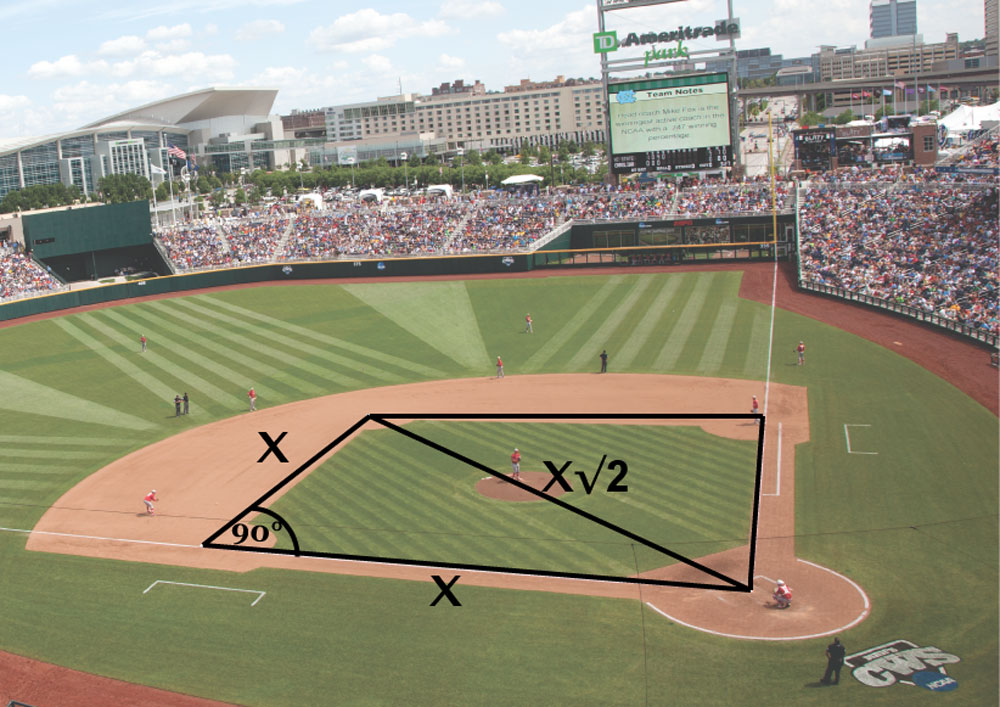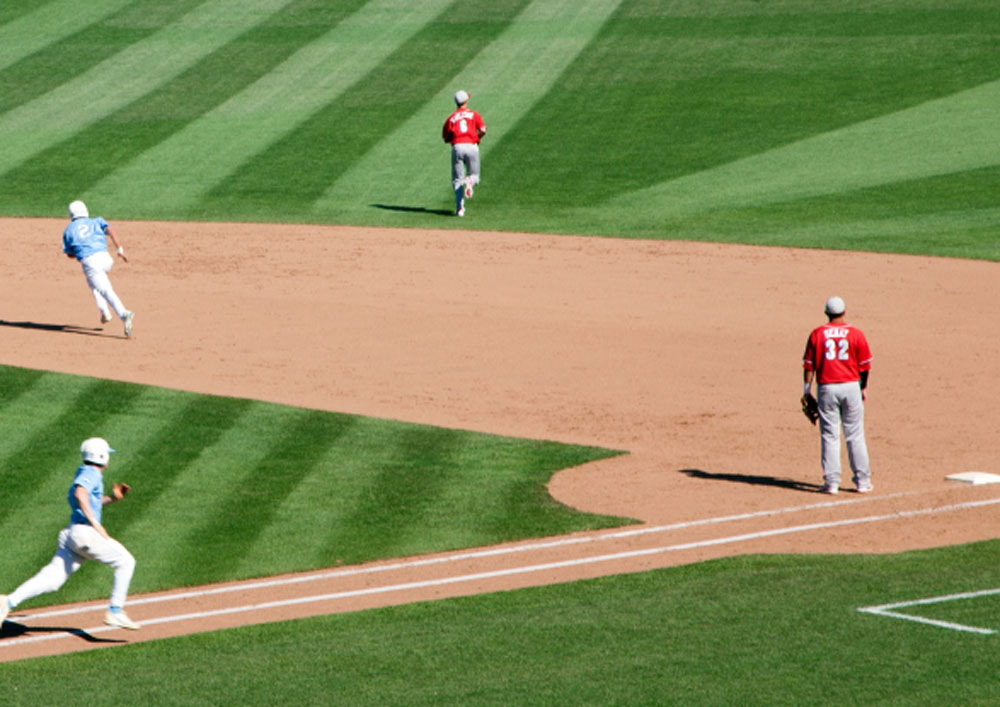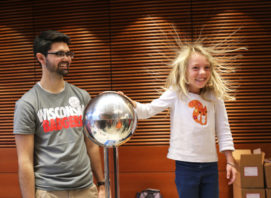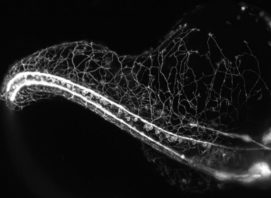Science of baseball: STEM at the College World Series
Every year since 1950, eight NCAA Division I baseball teams head to Omaha, Neb., to compete in the College World Series. Fans gather, sport team colors, tailgate outside the stadium or chant encouragements from the bleachers, and enjoy the camaraderie of this summertime tradition.
But beneath the apparent athleticism of the players and the strategies of the coaches is a foundation of scientific principles and technological advancements. Basic science, technology, engineering and math (STEM) connections are seen in the players, on the field, and as a part of the practiced techniques in pitching, hitting and running the bases.
COLLEGE BASEBALL PLAYERS
While players from the eight teams in the 2013 College World Series qualified for the competition because of their athletic skills, they are also students held to certain academic standards. Balancing athletics and academics can be tough and some of these players spend their time pursuing various STEM majors.
With majors ranging across the eight teams from mechanical engineering to horticulture to biological sciences, STEM fields are represented by the players and the game itself. Read more about some of these players below.
Tarran Senay
N.C. State University, first baseman/outfielder
Majoring in technology, engineering & design education
Tarran Senay always had an interest in computers and how they worked, leading him to major in technology, engineering & design education, focusing more on the technology side than teaching.
“It interested me, I came to N.C. State and chose that major, and it’s been a blessing ever since,” Senay said. “You can do anything basically in the technology field.”
If Senay wanted to end up teaching technology, he could apply for his license.
“I have taken classes on teaching and lessons plans and STEM education, so I have a pretty good wealth of knowledge about all that,” Senay said.
Senay said he thinks teachers can get more children interested in STEM fields by better explaining the opportunities within each field and the fun things they can do. There’s a group within Senay’s field of study that builds robots.
“We have a robot exhibit, and we can build stuff and take it to competition,” Senay said. “So there’s multiple things you can tell kids that are interested in majors such as technology and different [examples] to get them interested.”
Kyle Hart
Indiana University, pitcher
Majoring in environmental science
Kyle Hart said majoring in environmental science seemed a natural fit after spending a lot of his childhood out at a farm.
“I grew to like nature, and I enjoy being outside,” Hart said. “ I went to my advisor and said I like science, I like math, and he pointed me toward [environmental science]. So far, it’s been going really well.”
Hart said it can be tough to balance his academic career with baseball, but that he recognizes all the great opportunities offered by his education.
“Trying to manage our environment… it’s really becoming a business of today, everybody going green and all that,” Hart said. “I’m not saying I’m out here hugging all the trees but we’re going to need to start sustaining our environment if we want to continue what we’re doing. [Environmental science] is an incredibly important field, and if you like it I would push anyone towards it.”
Ryan Deeter
University of California Los Angeles (UCLA), pitcher
Majoring in mathematics/economics
Ryan Deeter, a pitcher for the UCLA Bruins, is the 2013 NCAA Elite-89 award winner for the Division I Men’s Baseball Championship, an award that recognizes athletes with high academic and athletic achievements. With a 3.927 GPA, Deeter was presented with the award at the College World Series Opening Ceremonies on June 14. According to a UCLA news release, Deeter plans to use his degree to go into finance and investment banking, or even use his mathematics skills in a sports environment.
SCIENCE OF BASEBALL
Baseball Diamond
Baseball statistics is the primary way math intertwines with the sport, but the shape and dimensions of the field itself are commonly used in math classrooms today to teach concepts of right angles and the Pythagorean theorem (a2+b2=c2). The Mathalicious team, profiled in May, offer a lesson on the Pythagorean theorem and stealing second base.
Janine Huldie, with a master’s in math education, has blogged about her use of the baseball diamond to teach these basic math concepts.
The sides of a baseball diamond are all of equal length, typically about 90 feet. Therefore, if you know the length of either the diagonal or one of the sides, you can use the formula to determine the remaining lengths. This is useful for determining how far a player would have to throw a ball to make an out or a double play—these concepts combined with distance and velocity of runners or wind resistance could make these problems more challenging and applicable for students.
Pitching Mechanics
The biomechanics of a pitcher’s movements, air resistance and the velocity of the baseball all play a part in the delivery of a pitch, whether it be a curve ball, fast ball, or the often-studied knuckle ball.
The pitch starts with a wind-up, where the pitcher uses his entire body to deliver momentum from his body to the ball. The team at Exploratorium explain this movement as “whip-like,” with movement beginning at the largest base and traveling through to the tip of the whip; or in this case, from the player’s legs, up through the shoulders, down the arm and into the fingers to release the ball at a high velocity. The height of the both the pitcher and the pitcher’s mound can affect movement and the velocity of the pitch.
Different types of pitches are determined by the grip on the ball and the movement of the wrist as the ball is thrown. As the ball is released, the direction and force of the spin, generated by the specific grip and wrist movement, determine how fast the ball will move and what path it will follow. The Exploratorium team offer an activity that exemplifies the biggest differences between the types of pitches and how to throw them.
For more information, Alan Nathan, a researcher at the University of Illinois, has published papers on scientific concepts related to baseball such as an analysis of knuckle ball trajectories and the effect of spin on the flight of a baseball.
Hitting Technology
The success or failure of not only hitting a baseball but hitting it effectively depends as much on the biomechanics of the batter’s swing as it does on the pitch and the type of bat used.
The reaction time of the batter must be minuscule if they want to make contact with the ball; knowing the best time to start the swing and the angle to hit the ball could make all the difference.
University of Michigan researchers have developed a device that tracks the bat’s movements as a player swings, recording data that measures the acceleration rate of the bat, as well as rotation. As small chip placed on the bat, the device is easy to install and almost instantly transmits data wirelessly.
In a video describing the technology, University of Michigan mechanical engineering professor Noel Perkins said “reaction time, speed and control; if you line those things up, you’re a great hitter.”
Coaches and players could use this device and the data it collects to determine best hitting practices for each player, as well as track attempts to improve swing.
Base Running Strategy
While the shortest distance between two points may be a straight line, baseball players have long known this path may not be the fastest. Researchers at Williams College have found that not only should players run as they tend to do intuitively, in a more rounded fashion, the perfect base running path may be more circular from the first step.
The optimal base running path, illustrated in the published article, suggests starting out 25 degrees right of the baseline. This contradicts the practice of first running directly down the baseline to first base, then deviating into a rounded path as the player heads for second base.
This strategy is optimal for all runners regardless of their running speed, but is meant to be used when the player is running through more than one base. There is nothing to show this would still be optimal for single hits or steals. Though the path obviously deviates from the baseline, the researchers have confirmed that it is legal within the rules of the game.





